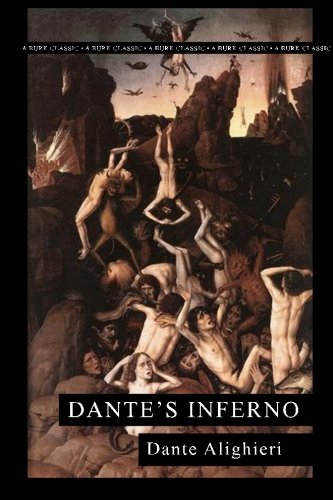Welcome, my friends! Today, I’m taking you on a wild, fiery ride with my honest review of Dante’s Inferno. Yes, the book with the circles, the screams, and more drama than my family barbecues. If you’ve ever wondered what happens when a poet gets lost on his way to work and ends up on a whirlwind tour through Hell, you’re in the right place. Stick around because I’ll talk about the good, the bad, and the oddly entertaining parts that made me laugh, cringe, and scratch my head (sometimes all at once!). Let’s get started—don’t forget your fireproof boots!
In a nutsheel
Alright folks, let me set the scene. Dante’s Inferno is a classic poem by the Italian guy Dante Alighieri. No, he’s not from Jersey. This book is the first part of his huge work, The Divine Comedy. It’s old, but don’t be scared! It’s a wild mix of adventure and epic fantasy with a sprinkle of horror.
Dante’s Inferno follows, you guessed it, a fella called Dante. He takes a spooky trip through the nine circles of Hell. With his guide Virgil (who is way cooler than your Google Maps), he meets weird and scary creatures, and some folks that aren’t having the best day. The book digs into deep stuff like sin, punishment, and what it means to be a decent (or terrible) person. Themes of justice, mercy, and hope pop up as well.
This is a poem, so it rhymes (sort of) and the language can be tricky, but the story is big on drama, action, and real-life questions. If you’re into books about the afterlife or want an old-school classic that still gets people talking, Dante’s Inferno is worth a look!
Dante’s Wild Ride: From Inferno to Paradise
If you think your daily commute is a nightmare, wait till you read Dante’s Inferno. Dante kicks off his journey with a trip through Hell, all because he got lost in a spooky forest. Lucky for him, the poet Virgil pops up to play tour guide. Together, they walk past some truly wild punishments, like people running from wasps and others stuck in rivers of boiling blood. I couldn’t help but laugh when Dante acts all shocked—like, buddy, you’re in Hell, what did you expect? But hey, at least he’s not alone.
After Hell, the party moves to Purgatory, which is less fire and more rehab. Here, souls work off their mistakes, climbing a steep mountain. This mountain is so long, I needed a nap just reading it. But Dante keeps meeting folks he used to know, which must be awkward. Imagine seeing your old neighbor, but instead of at the store, you see them rolling a boulder up a hill for all eternity. Some friends, right?
At last, Dante makes it to Heaven. Frankly, this is where things get real shiny and confusing. Instead of fire and monsters, now everyone’s talking about love and light. Beatrice, Dante’s old crush, shows up as his new guide, and honestly, she’s way less patient than Virgil. Dante is wowed by all the sparkly stuff and music—it’s like the best concert ever, but you have to be perfect to get in.
Next, I’ll show you how all this madness is packed with strange symbols—get ready for some wild mental pictures!
Symbolism and Imagery in Dante’s Inferno: Exploring Every Realm
Dante’s Inferno is not just a hot mess of lost souls, flames, and poetic justice—it’s basically a Where’s Waldo of deep symbols. Through each realm, Dante gives us wild stuff to spot and think about. In Dante’s Inferno (the first realm), fire isn’t just for BBQs and toasted marshmallows, it’s a big neon sign for pain and regret. Rivers like the Acheron and the Styx aren’t your regular fishing spots either. They show us how sin never really washes off (trust me, I’ve tried with dish soap). Plus, all those circles? They make you wish you’d never flunked geometry, but really, they show how sins and punishments match up in weird and clever ways.
Purgatory, the next stop, goes all-in on climbing. The mountain isn’t just a leg day workout—it’s an image for self-improvement and hope. The souls there look like hikers in a motivational poster, sweating it out and looking for a view at the top. Symbols like the angel wings and the soft glow of sunlight hint that maybe, just maybe, there’s a good ending waiting if you put in the work (I’d bring extra water, though).
Once you reach Heaven, Dante’s imagery gets bright and sparkly like someone found the Instagram filter for spiritual bliss. All those circles of light? They show the unity and perfection of the divine. The stars and music up there are like a cosmic after-party, full of grace and good vibes.
Stay tuned, because the next section will bring you drama, tough choices, and more characters than my family at Thanksgiving dinner!
Meeting the Locals: Character Interactions and Moral Lessons in Dante’s Inferno
Let’s talk about characters in Dante’s Inferno. When you and your best pal Virgil tour the circles of Hell, it feels a bit like getting stuck at family dinner—with a few extra fire pits and monsters. Dante keeps running into people he, or honestly, most of Florence, knew. Sometimes these old acquaintances are not thrilled to see him. My buddy Jerry says it’s a bit like running into your old boss at the DMV, only this time, your boss is stuck in boiling blood. Awkward.
The encounters are the best part. Virgil, who’s like the world’s chillest tour guide, gives lots of side-eye as Dante freaks out. Every character Dante meets has their own sob story. Take Francesca and Paolo, doomed to twirl about in a never-ending wind because of their steamy romance. Dante actually cries for some of these folks, which my friend Lisa said is touching, but I think he just feels guilty for bringing snacks to a place where everyone is starving.
The moral lessons are about as subtle as a sledgehammer. Greed? You get to roll giant bags of money forever. Anger? Prepare for a mud fight with no soap. But it’s not all gloom; Dante seems to say, ‘Hey, everyone messes up, but owning up to your mistakes is key.’ Sometimes the characters blame everybody else, and Dante is quick to point out their denial. Me and my friends got endless debate mileage out of who deserved their spot—and who didn’t.
If you’re ready for some wild poetic swings and lines that make you go, ‘Wait, what did he just say?’ stay tuned, because next we’re talking writing style and readability for newcomers!
Is Dante’s Inferno Tough Reading for Newbies? Steve Spills the Beans
When I first tackled Dante’s Inferno, I felt like a tourist who forgot a map and also can’t read Italian. The language is fancy. The sentences twist and turn more than my garden hose. If you think you’ll just zip through this book like it’s a comic, you’re in for a surprise—unless your favorite comics feature footnotes and medieval Italians.
For newcomers, readability is tough. We’re talking about a poem written 700 years ago, which is basically dinosaur speak with extra metaphors. Even modern translations keep some old vibes. People don’t say things like ‘Abandon all hope, ye who enter here’ unless they’re working at the DMV or reading this book for high school. But that’s half the fun. Once you get used to the style, Dante’s wild imagination makes up for the rough ride. I started out checking the footnotes every two seconds, but eventually, I found myself kind of grooving with the flow—like when you finally get the hang of karaoke after a few terrible songs.
I gotta warn you, though: If you’re allergic to poetry, this book might make you itch. And if you want quick answers or TikTok-length chapters, you won’t find it here. But if you give it a chance, Dante’s Inferno is full of lines that stick in your head, and clever ways of showing how messy people (and Hell) can be.
Would I recommend it? Sure—if you don’t mind getting lost a few times and laughing at your own confusion. It’s like hiking up a weird, spooky mountain: tough, but the view is totally worth it.
Conclusion
Alright, folks, that wraps up my journey and wild ride through Dante’s Inferno. This book is a wild mix of drama, spooky creatures, and big questions about life, bad choices, and redemption. I had a blast reading it, even when I got confused (which was a lot). Sure, the old-timey language made me scratch my head so hard my hat almost flew off, but it’s worth it for all the cool scenes and the weird, wonderful cast of characters. If you’re looking for a classic that makes you think, squirm, and maybe laugh a little, you can’t go too wrong here. Just bring patience and maybe a flashlight. That’s it for my review—thanks for hanging out, and happy reading!


